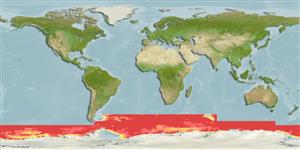Classification / Names
Common names from other countries
Main reference
Size / Weight / Age
Max length : 75.0 cm TL male/unsexed; (Ref. 1371)
Environment
Marine; bathypelagic; oceanodromous (Ref. 51243); depth range 400 - 3185 m (Ref. 1371), usually 600 - 1500 m (Ref. 1371)
Climate / Range
Deep-water, preferred -1°C (Ref. 107945); 47°S - 79°S, 180°W - 180°E (Ref. 1371)
Distribution
Short description
Dorsal
spines
(total): 2;
Dorsal
soft rays
(total): 124-125;
Anal
spines: 0;
Anal
soft rays: 110. Eyes relatively large. Snout short, moderately pointed, usually somewhat rounded with a high dorsal profile in adults, but often with prominent tubercles at its tip and lateral angles. Mouth large, lips thin. Underside of the head generally covered with small scales. Pyloric caeca 18 to 28. Overall color dark brown to swarthy in most individuals, but some are much paler; fins and lips blackish (Ref. 1371).
IUCN Red List Status (Ref. 115185)
Threat to humans
Harmless
Human uses
Fisheries: commercial
More information
Common namesSynonymsMetabolismPredatorsEcotoxicologyReproductionMaturitySpawningFecundityEggsEgg development
ReferencesAquacultureAquaculture profileStrainsGeneticsAllele frequenciesHeritabilityDiseasesProcessingMass conversion
Tools
Special reports
Download XML
Internet sources
Estimates of some properties based on models
Phylogenetic diversity index
PD50 = 0.5312 many relatives (e.g. carps) 0.5 - 2.0 few relatives (e.g. lungfishes)
Trophic Level
3.5 ±0.49 se; Based on food items.
Resilience
Very Low, minimum population doubling time more than 14 years (Preliminary K or Fecundity.)
Vulnerability
High vulnerability (64 of 100)
Price category
